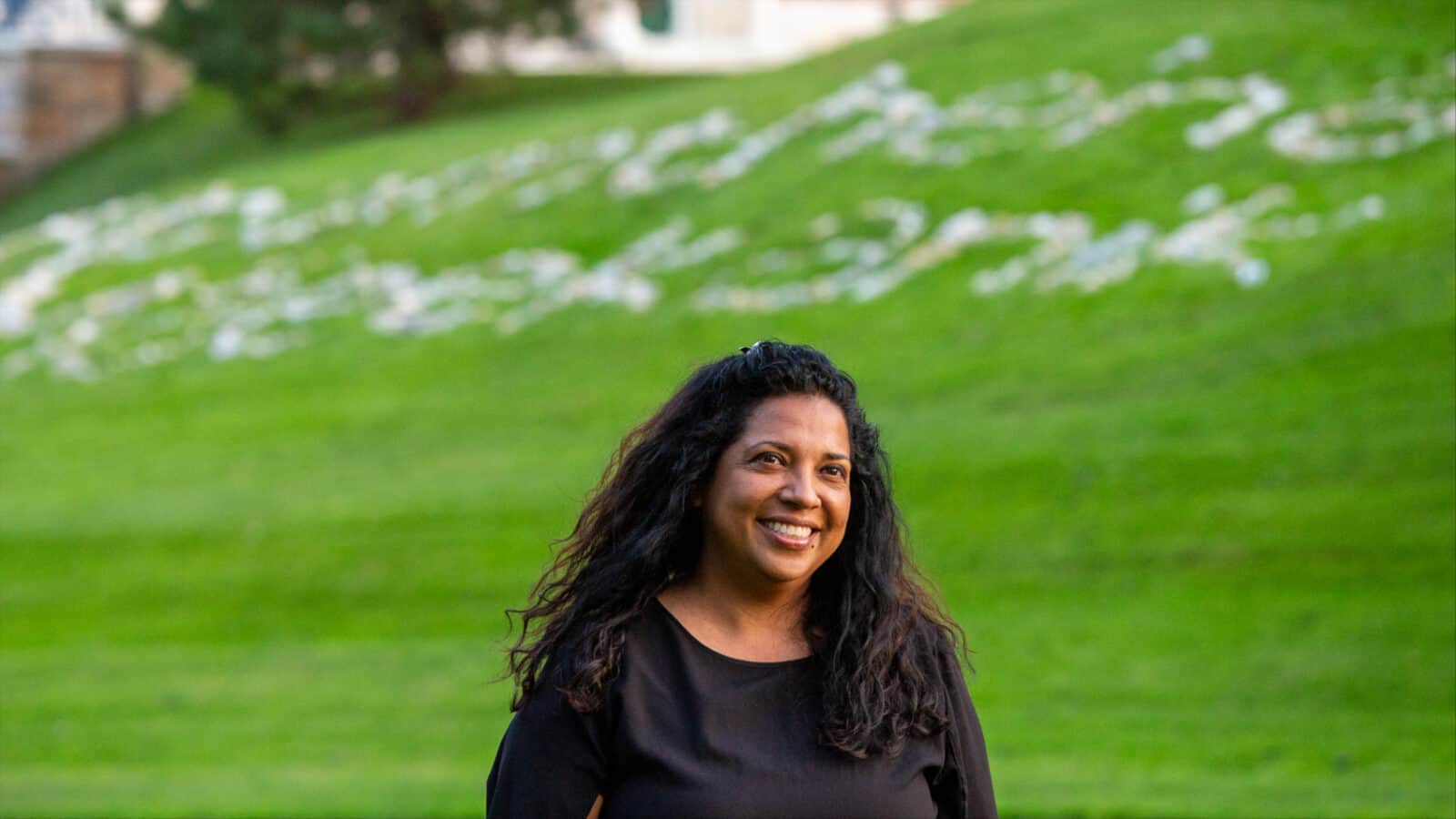A group circles around a fireplace and a stone hearth made by hand. Standing together in the sun on the first day of fall, they are looking at the inside of a living space set outside.
In the years when the college was coming into being, people might have gathered by a fire like this. They might have warmed themselves on cold early mornings, Prince, J. Romanoo, Moni, London and Cloe — the five enslaved people forced to work in the household of the college’s founder, Ephraim Williams.

A group of students and visitors join artist Beatriz Cortez to talk about her work in Portals at Williams College. Press photo courtesy of Wiliams College
Los Angeles artist Beatriz Cortez speaks to them, and many others around them, in Portals at the Williams College Museum of Art, sharing a resonance with Antigua and Guatemala and El Salvador.
She is weaving stories through time in her new art installation, indoors and outdoors at the center of Williamstown. She invokes the lives of people who have lived here — people people who have believed in equality, justice, curiosity, diversity and freedom.
She has planned this exhibition over many years, she said, leading a tour of her work with students and professors and folk in the community. Students in art history first introduced WCMA to her work; born in San Salvador, she lives and works now in Southern California. And she has explored the past and present here in conversations and research with students, professors and staff.
Lifting hidden voices
When she first came to Williamstown to talk with the museum, in 2019, she said, she felt the presence of people too often not seen and heard, and she wanted to know them.
Looking around her at the college today, she felt the influence of colonial architecture, and she felt an invisibility she knows well in Los Angeles — the invisibility of the people who make houses and gardens beautiful and care for children.
So she has re-imagined a space from the inside of a historic colonial house and set this place in the sun. And she has planted it at the center of the town and the college, at the meeting of Main Street and Spring Street.
She planned to set the hearth under a broad old oak, she said, but the pandemic slowed the opening of her show, and the college took down the tree. So now she has set her hearth on the earth where the tree has stood for generations.
“People in the house would have had to have warmth,” she said. “I imagined the places in the attic, invisible to the outdoors, where people would sleep, dry clothing, do what they needed to do because they didn’t have what they needed. I wanted to make visible the presence of enslaved people in Williamstown and the conditions in which they lived.”
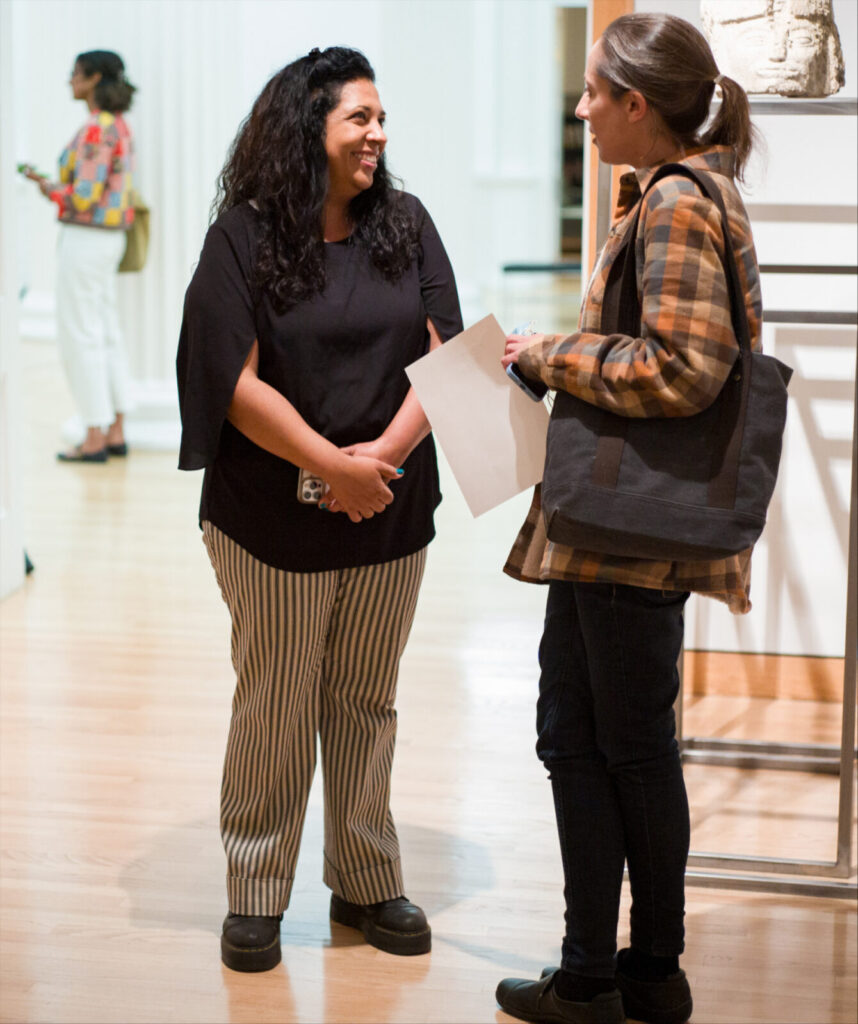
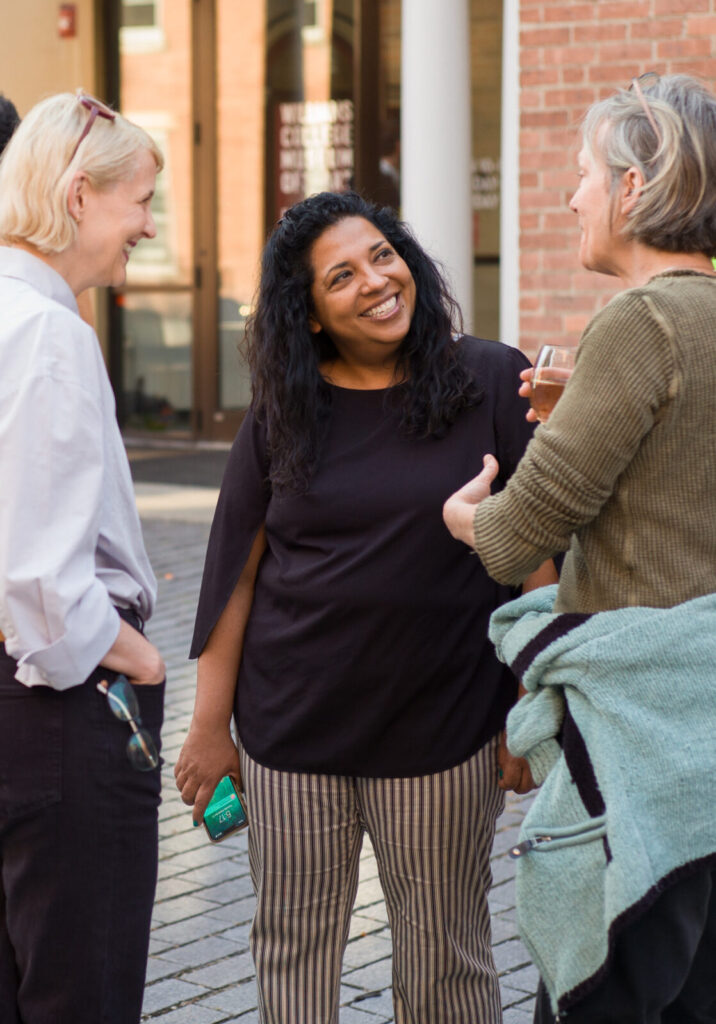
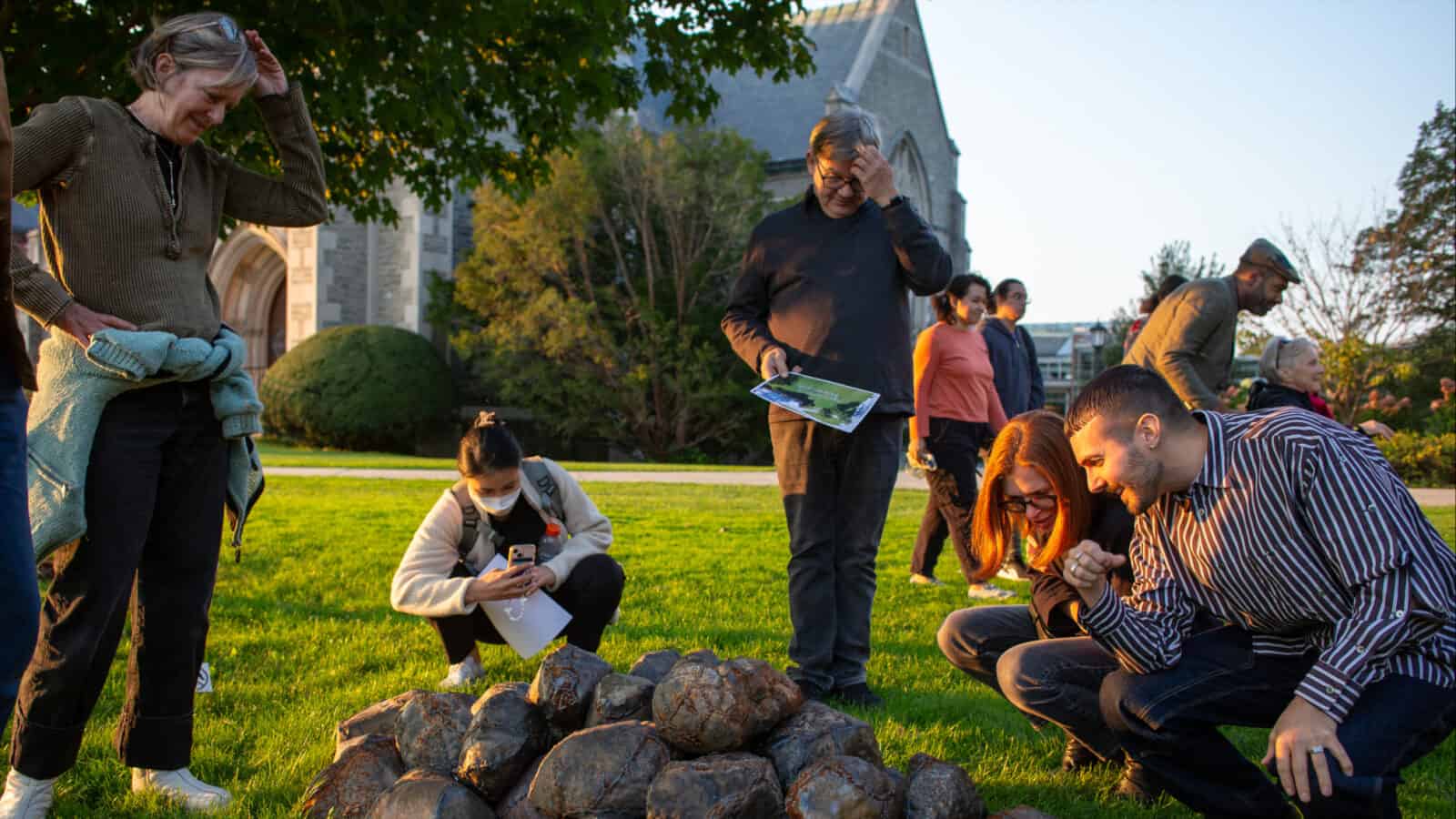
A group of students and visitors join artist Beatriz Cortez to talk about her work in Portals at Williams College. Press photo courtesy of Wiliams College
Weaving strength and shelter
To honor them, she draws on her own experiences in Antigua and Guatemala, and on long and deep traditions of Indigenous artwork and belief, storytelling and making in South and Central America.
Beside the hearth she has set a petate (in Náhuatl, the language of the Mexica) — an artform that has lived across centuries, she said, a way of weaving long leaves of grass. Singly they may bend, but together they will not break.
“The weaving becomes a symbol of community,” she said. “In ancient times, they were sacred.”
In images and relief sculptures, weavings, Indigenous artists would show people in authority sitting on a petate as a symbol of power and independence and respect — a symbol of the cycle of life and death.
She wanted to give respect for the people who would have lived around this hearth, she said, here where they would kneel or sleep. She has given them tools for food and warmth and family — a woven basket and a two-handled pot to heat water.
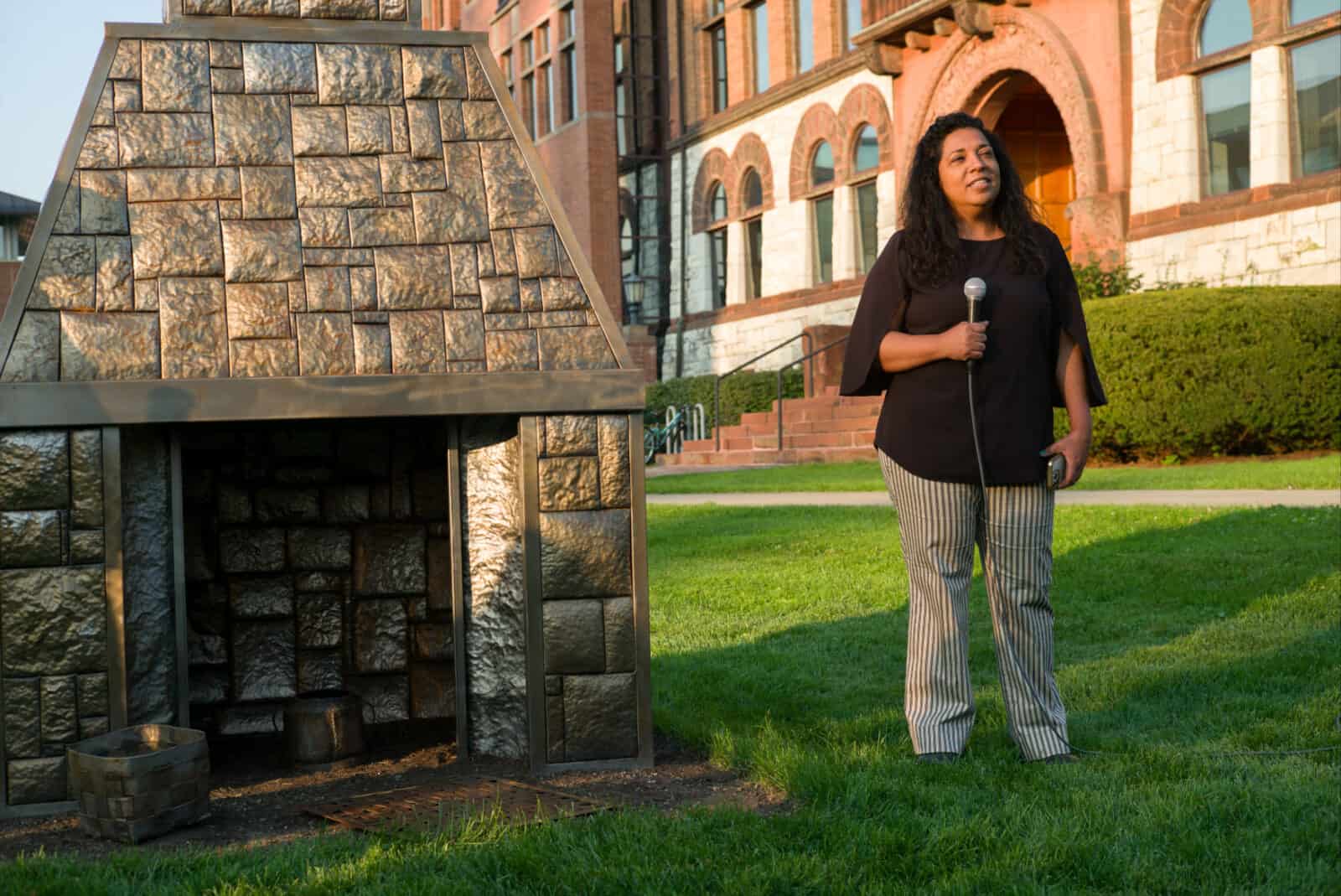
Los Angeles artist Beatriz Cortez talks about Historic House 2022-23, about her work in Portals at Williams College. Press photo courtesy of Wiliams College
Hands to work
Above them she has formed the fireplace stones from steel tiles pitted like cast iron and burnished with patina of rust. She has made each one by hand, she said, working with a team of artists
She loves immersing in the work of making, and the freeform and improvisational nature of shaping the metalwork pieces to fit the slanting lines of the hearth. She has a saw that cuts only at one angle, and so she and her artists cut the corners of the bell-shaped section by hand.
She and her team have placed each piece so the pattern would not repeat, she said, and sometimes they would make one on purpose that did not fit exactly, as though the people who lived here were trying to patch a place where the stone had worn and broken. The process becomes absorbing.
“I go to bed each day thinking, what do I need to fix,” she said, laughing.
And she finds depth in the experience of giving the work of her own hands to honor the people who have lived and worked here
“Our labor becomes symbolic of their labor. It is joyful to make things by hand to honor others I have never met.”

A group of students and visitors join artist Beatriz Cortez to talk about her work in Portals at Williams College. Press photo courtesy of Wiliams College
A cairn for ancestors
The hearth bricks are two-dimensional tiles, but a few steps eastward, on the grass outside of Griffin Hall, she has made a cairn of rounded handmade stones. She often makes three-dimensional metalwork in the shapes of river rocks, she said, and sets them together as Indigenous people do in Central America.
“To put these rocks here is one of the greatest gifts I can give,” she said, “because so much labor goes into making (them).”
She gives them here to mark the resting places of ancestors who have no gravestones. When she walked through campus for the first time, she came to the college cemetery, where tenured faculty and their families can be buried.
And she thought of the graves that have no markers now. In the country where she was born, mass graves hold unnamed bodies all across El Salvador, the bodies of the disappeared. And she has lived in Arizona, where people cross the desert and die just as unmarked, people who are trying to reunite with their families.
‘Giving gifts to unknown others we’ve never met is important.’ — Beatriz Cortez
She has heard of people digging foundations here in the Northeast and disturbing the bones of people buried years or centuries ago.
“We don’t know where the people who lived here first are buried,” she said.
Where do the ancestors lie of the Mohican community centered now in Wisconsin? And how many of the graves of the Black families in the community have markers — the free people who have lived here more than 200 years, the communities on White Oaks Road and along the river?
“Giving gifts to unknown others we’ve never met is important,” she said, “and to honor our ancestors and the ancestors of others.”

Artist Beatriz Cortez reaches out to her cairn of stones as a group of students and visitors join artist Beatriz Cortez to talk about her work in Portals at Williams College. Press photo courtesy of Wiliams College
She has set them outdoors and on the earth, and that connection matters to her, a call to the rhythms of life and death, a journey to the underworld, and back up, and back down again. Her stones are vulnerable here to time and weather.
“Life goes on,” she said, “and there’s something important about that.”
She wants her stones to lie here open to the sky and the earth … spangled with spiderwebs, where creatures underground and above ground can climb and fly around them. She hopes to see them in the snow, and on the first day when the snow begins to melt.
“They give an invitation to learn about where we are standing,” she said.
‘Walking on Mohican homelands
Looking across the road to the hill below the observatory and the short, round tower of the old telescope and planetarium
she has set stones, real stones smoothed in rivers here. They say Kpomthe’nã Mã’eekanik in the Mohican language, a phrase she has chosen in conversations with members of the Stockbridge Munsee Community language program: We are walking on Mohican homelands.
The Stockbridge Munsee community of the Mohican nation has a home in Wisconsin today, and these hills are their homeland. They return often, and they have an office now on Spring Street and an evolving relationship with the college.
Cortez has talked with Bonney Hartley, historic preservation officer for the Mohican Nation, who lives here, and she has met Williams students who have worked with her. They told her the story of the banner they created together two years ago to honor the Mohican community with a central presence on campus — the banner hung on the student center at Paresky, but only for a week before college policy made the students take it down. Cortez’ work will stay here on the land for a year at least.
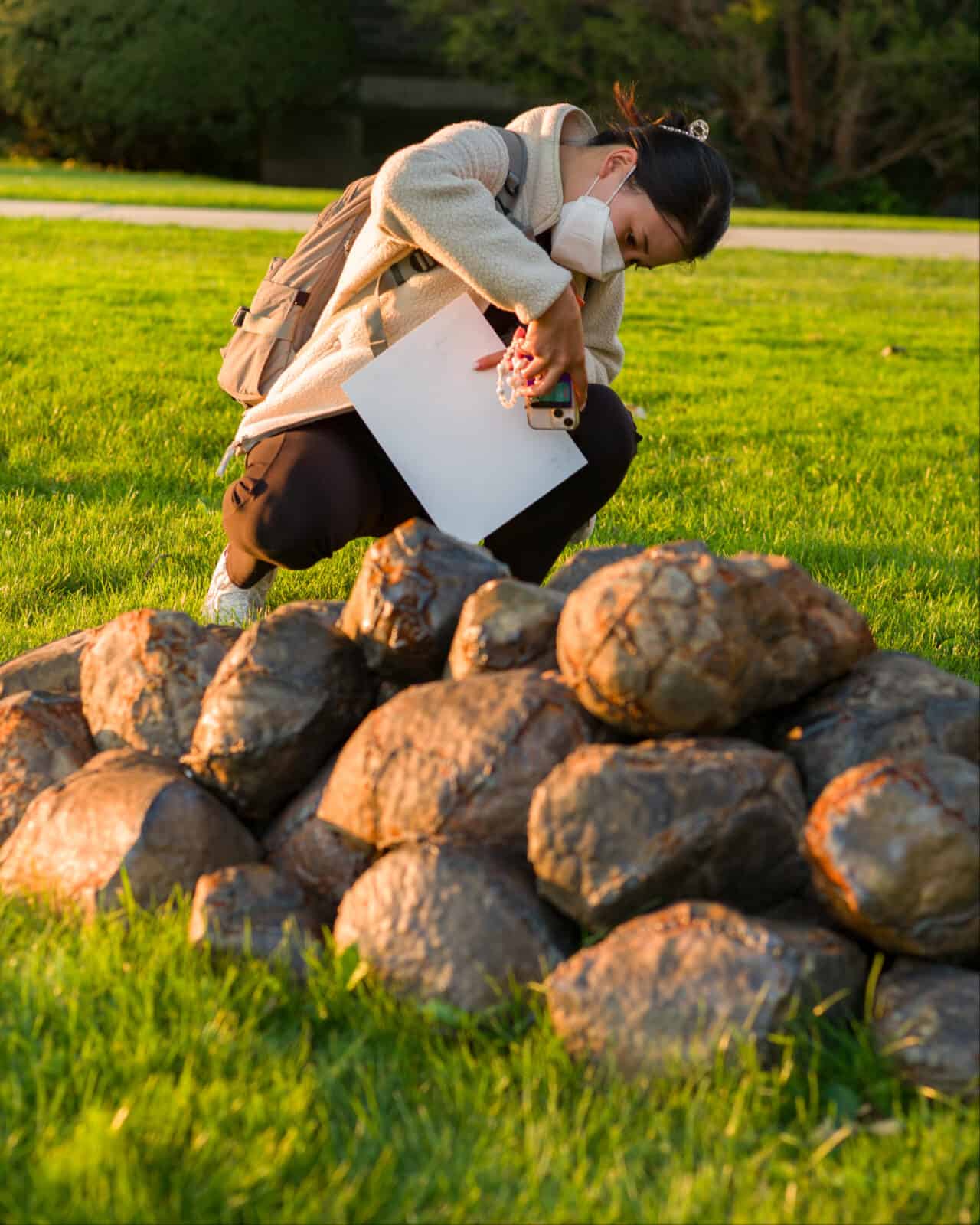
A student looks closely at XX, a cairn of handmade steel 'stones' in Beatriz Cortez' Portals at Williams College. Press photo courtesy of Wiliams College
She plays the words aloud, Kpomthe’nã Mã’eekanik, so that the group will hear them in a living voice, in the voice of a man who speaks them as his own language.
‘They give an invitation to learn about where we are standing.’
And then, walking into the museum, into the central open space, she asks the group to listen to another voice, or to many voices, in a work she has made invisible and intangible — but alive in sound.
In many voices, she gives a voice to Luce Bijah, Lucy Terry Prince — a free woman, a Black poet who performed her own words and sang her own songs in her kitchen in Deerfield and made a gathering place for her friends. In 1793, she is said to have argued with the college to accept her son.
Festus had served with West Point in the American Revolution. He was a veteran, a young man inclined to festivity, a natural musician and a lively talker. Cortez has drawn on her own research to hear his voice and his mother’s. People have questioned her, she said, whether she should speak for a Black woman, and she has thought with care and then asked people close to her to give their voices as part of the work.
“I am imagining her, listening to her,” she said.
Luce Bijah lived near here in Deerfield and later in Sunderland, Vermont. Kidnapped in Africa, forced into slavery, she married and won her freedom.
Cortez’ friends and family imagine her voice as she shares her story and advocates for her son, and for education and democracy.
“If you accept him, he will be able to participate in public debates about the slave trade and the education of women. … If you do not accept him, you will set a precedent for the exclusion of many others.”
As Cortez stands here today to hear and see her work in place, she asks what the college would look like now, if they had agreed.

